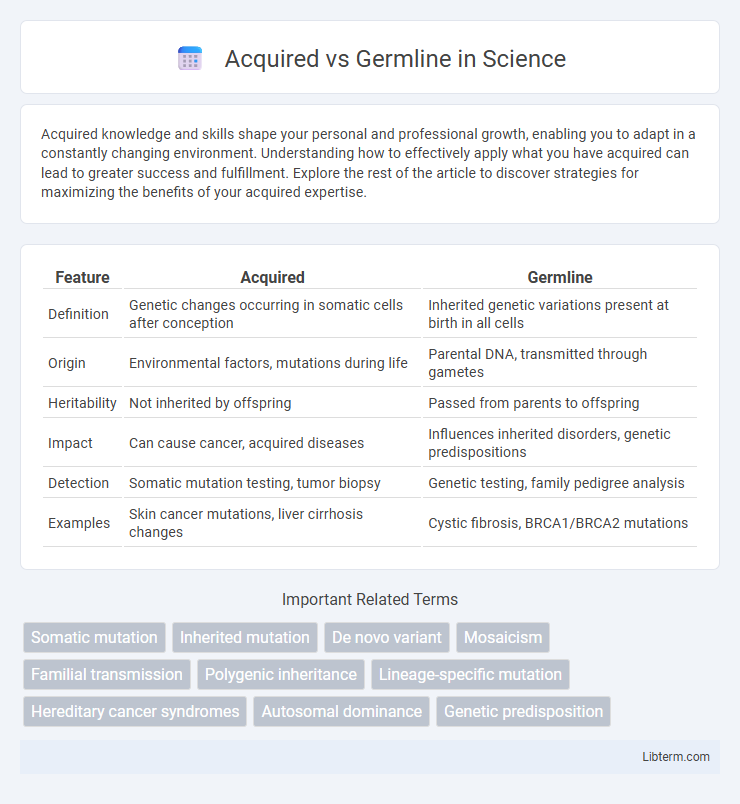Acquired knowledge and skills shape your personal and professional growth, enabling you to adapt in a constantly changing environment. Understanding how to effectively apply what you have acquired can lead to greater success and fulfillment. Explore the rest of the article to discover strategies for maximizing the benefits of your acquired expertise.
Table of Comparison
| Feature | Acquired | Germline |
|---|---|---|
| Definition | Genetic changes occurring in somatic cells after conception | Inherited genetic variations present at birth in all cells |
| Origin | Environmental factors, mutations during life | Parental DNA, transmitted through gametes |
| Heritability | Not inherited by offspring | Passed from parents to offspring |
| Impact | Can cause cancer, acquired diseases | Influences inherited disorders, genetic predispositions |
| Detection | Somatic mutation testing, tumor biopsy | Genetic testing, family pedigree analysis |
| Examples | Skin cancer mutations, liver cirrhosis changes | Cystic fibrosis, BRCA1/BRCA2 mutations |
Introduction to Acquired and Germline Genetic Variations
Acquired genetic variations occur in somatic cells and are not inherited, arising during a person's lifetime due to environmental factors or DNA replication errors. Germline genetic variations are inherited mutations present in the egg or sperm and passed on to offspring, affecting every cell in the body. Understanding the distinction between acquired and germline mutations is crucial for genetic testing, cancer diagnosis, and personalized medicine strategies.
Defining Acquired (Somatic) Mutations
Acquired (somatic) mutations occur in non-germline cells after conception, arising due to environmental factors or errors in DNA replication during cell division. These mutations are not inherited or passed to offspring but can lead to diseases such as cancer by affecting cellular function and proliferation. Detecting somatic mutations requires analyzing affected tissues, distinguishing them from inherited germline mutations present in all cells.
Understanding Germline Mutations
Germline mutations occur in reproductive cells and are inherited by offspring, affecting every cell in the body and contributing to genetic disorders or hereditary cancers. These mutations differ from acquired (somatic) mutations, which arise in individual cells during a person's lifetime and are not passed to progeny. Understanding germline mutations is critical for genetic counseling, early disease detection, and developing personalized preventive strategies.
Key Differences Between Acquired and Germline Mutations
Acquired mutations occur in somatic cells and are not inherited, affecting individual cells during a person's lifetime, often contributing to cancer development. Germline mutations are inherited genetic changes present in egg or sperm cells, passed from parents to offspring, impacting every cell in the body. Key differences include their origin, inheritance patterns, and roles in hereditary diseases versus sporadic conditions.
Causes of Acquired vs Germline Mutations
Acquired mutations result from environmental factors such as UV radiation, chemicals, or viral infections that damage DNA during a person's lifetime, leading to alterations in somatic cells. Germline mutations are inherited from a parent's reproductive cells and occur due to errors in DNA replication or repair mechanisms during meiosis, causing permanent changes present in every cell of the offspring. Understanding these mutation causes is crucial for genetic disease risk assessment and targeted therapies in oncology.
Inheritance Patterns and Family Risk
Germline mutations are inherited from a parent and present in every cell, significantly impacting family risk as they can be passed to offspring, often following dominant or recessive inheritance patterns. Acquired mutations occur spontaneously in somatic cells and are not inherited, meaning they do not increase familial risk or follow classical inheritance models. Understanding whether a mutation is germline or acquired is essential for genetic counseling and assessing cancer risk within families.
Impact on Disease Development and Progression
Acquired mutations, occurring after conception, often drive disease progression by altering somatic cells and promoting tumor growth or resistance to therapy. Germline mutations, inherited from parents, predispose individuals to disease by affecting DNA repair mechanisms or cell regulation pathways, increasing susceptibility from birth. Both mutation types influence disease development, with acquired mutations contributing to aggressiveness and germline mutations shaping overall risk and onset timing.
Diagnostic Approaches for Acquired and Germline Mutations
Diagnostic approaches for acquired mutations primarily involve somatic mutation testing using tumor biopsy samples and next-generation sequencing (NGS) to identify mutations occurring in specific tissues. Germline mutation analysis relies on blood or saliva samples analyzed through techniques like Sanger sequencing or whole exome sequencing to detect inherited genetic variants. Both approaches use bioinformatics tools to interpret variant pathogenicity, informing personalized treatment and genetic counseling.
Therapeutic Implications and Personalized Medicine
Acquired mutations, present only in tumor cells, enable targeted therapies such as tyrosine kinase inhibitors that specifically attack cancerous tissues while sparing normal cells, whereas germline mutations, inherited and present in all cells, inform risk assessment and guide preventive strategies in personalized medicine. Understanding the distinction between somatic and germline mutations is crucial for selecting appropriate treatments, as germline mutations may influence drug metabolism and toxicity profiles, necessitating tailored therapeutic regimens. Integration of genomic profiling in clinical practice enhances precision oncology by aligning therapeutic choices with the patient's unique mutation landscape, improving efficacy and minimizing adverse effects.
Conclusion: Importance of Distinguishing Mutation Types
Distinguishing between acquired and germline mutations is crucial for accurate diagnosis and personalized treatment strategies in oncology. Germline mutations indicate inherited cancer risk and influence genetic counseling, while acquired mutations are specific to tumor cells and guide targeted therapy decisions. Precise identification of mutation types enhances patient management, risk assessment, and therapeutic outcomes.
Acquired Infographic

 libterm.com
libterm.com